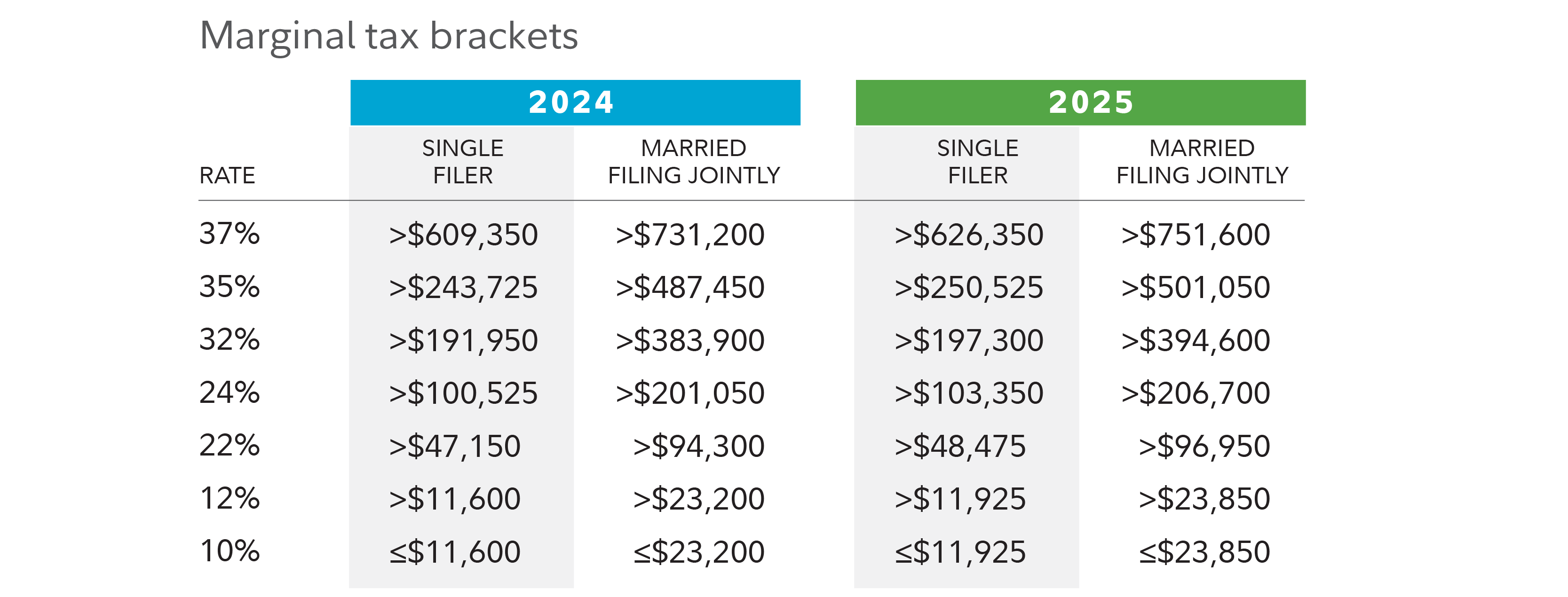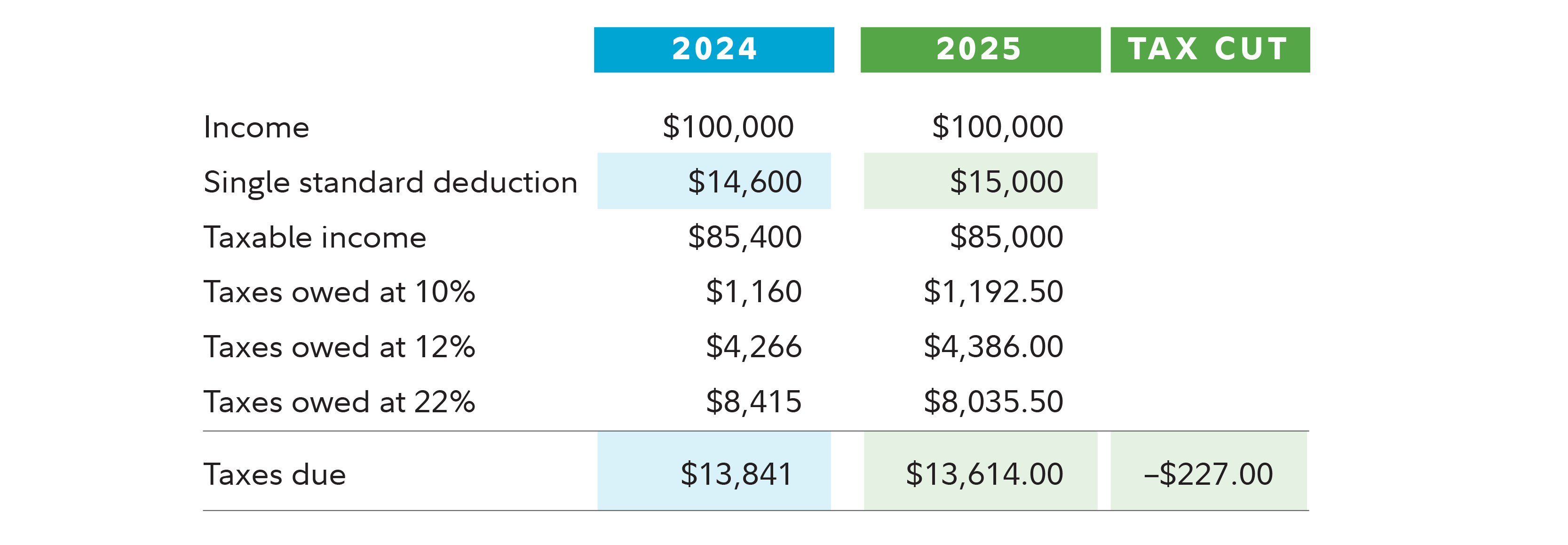With inflation slowing, taxpayers get a smaller inflation adjustment to tax brackets for 2025 than 2024, but may still see a tax cut.
The Internal Revenue Service (IRS) has released adjustments to tax brackets for 2025, adding thousands of dollars to most marginal tax brackets, and potentially protecting more of your income from taxes this year. The roughly 2.7% inflation adjustment is lower than the 5.4% increase for 2024, and much lower than the 7% increase for 2023.
Additionally, the standard deduction will rise. For married couples the bump up is $800 to $30,000. For single filers, it's an increase of $400 to $15,000.
Why do tax brackets change?
The US has a progressive tax system, meaning as someone's income rises, it's taxed at a gradually increasing rate corresponding to 7 brackets, which rise like a set of steps. Every year the IRS announces changes to the tax brackets. Those changes are pegged to inflation, and the adjustments occur at roughly the same time the federal government makes changes to Social Security payments through the cost-of-living adjustment (COLA).

How the 2024 and 2025 tax brackets might affect you
Here's how the changes might play out for an individual filer who earns $100,000 both in 2024 and 2025, and who takes the standard deduction in both years.

The $227 in savings is the result of the higher standard deduction, as well as a lower effective tax rate (the average tax rate applied to your income.) As brackets widen, more of your taxable income is taxed at a lower rate.
Even though the inflation adjustment to tax brackets is smaller than it has been in recent years, many have experienced earnings growth over the past year. Real weekly earnings increased by on average 1.8%. On average, taxpayers may expect to see lower tax bills as the tax brackets and standard deduction rose more than earnings.1
Tactics to help manage tax bracket changes
There are 2 ways you can take deductions on your federal income tax return: You can itemize deductions or use the standard deduction. The standard deduction is a dollar amount preset by the IRS. Itemizing means adding up all the deductions you may qualify for, up to a certain limit that could be higher than the standard deduction.
- If you itemize in 2024 and your itemizations in tax year 2025 will be less than the higher $30,000 standard deduction for married couples, or $15,000 for single people, switching to the standard deduction could make sense.
- If you're close to the standard deduction cutoff, even with the new amounts in 2025, additional charitable contributions could make itemizing more worthwhile. If that's the case, and donating to charity is one of your goals, you could also consider a "bunching" strategy for 2025. That essentially entails combining all your charitable deductions for several years in a single year, enabling you to exceed the standard deduction next year, and potentially allowing you to realize tax benefits from your donation. The following year, you may choose not to make charitable donations and you'd still qualify for the standard deduction, which could save you thousands of dollars in taxes over several tax years, while still making the same total charitable donations.
- Finally, if you've been thinking about a Roth conversion, next year might be a good time to do one. The new tax rates, combined with the recent fluctuations in stock prices, may mean the money you convert from a traditional IRA to a Roth could be taxed at a lower rate. A conversion for tax year 2025 might be particularly helpful for people who expect their tax rate to be higher in future years.
Important to know
An opportunity to save more in a 401(k)
In addition to tax savings, the IRS made adjustments to numerous other parts of the tax code that have an impact on retirement saving and more.
People who have access to a 401(k) plan through work can consider putting more money away next year, as the IRS also announced annual contribution limit increases for 2025. Participants in such plans can contribute $23,500 (pretax or to a Roth depending on plan rules), up from $23,000 in 2024. People 50 and older can make catch-up contributions of $7,500, the same as 2024.
Beginning in 2025, those between 60 and 63 will be eligible to contribute up to $11,250 as a catch-up contribution. This means those 50 to 59 or 64 or older will be able to contribute up to $31,000 in 2025 and those 60 to 63 will be able to contribute up to $34,750 in 2025.
2025 IRA contribution limits
IRA contribution limits are unchanged at $7,000 for 2025; catch-up contributions of $1,000 for those age 50 and over also did not change.
Contributions to a traditional 401(k) or a traditional IRA can reduce your taxable income, and deferred amounts are not taxed until you begin withdrawals in retirement.
2025 HSA contribution limits
Lastly, the IRS also increased health savings account (HSA) annual contribution limits. The inflation adjustment lets individuals save $4,300 in 2025, up from $4,150 in 2024. For family coverage, contribution limits for this year have jumped to $8,550 from $8,300. Those 55 and older can contribute an additional $1,000 as a catch-up contribution, which is unchanged from 2024. HSAs can help people save for rising health care costs now and in retirement.
All in all, the tax changes for 2025 should help offset some of the pain from continuing inflation and help people save for retirement. To make the most of these changes as you plan for the future, consider working with a tax professional.



